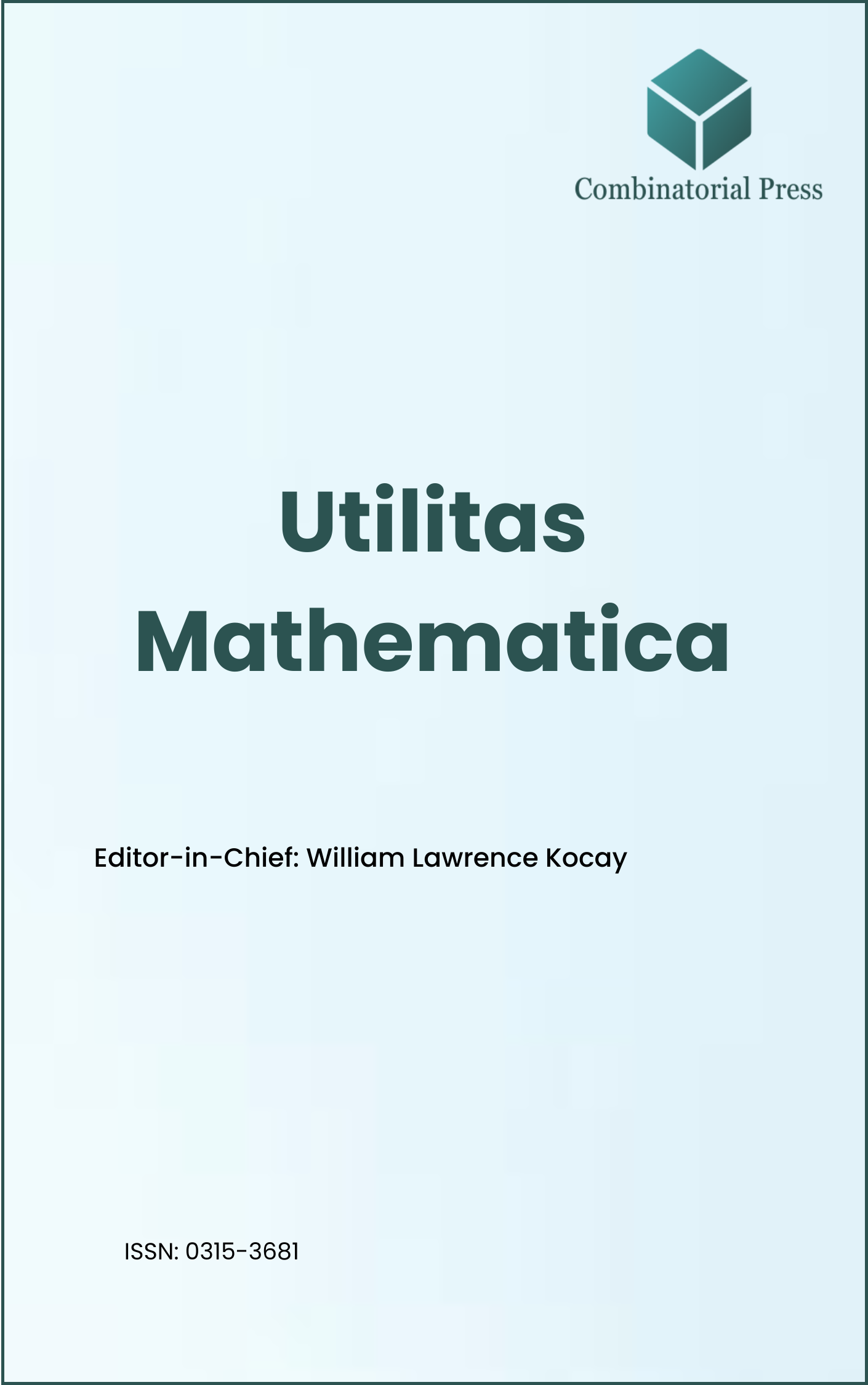
Utilitas Mathematica
ISSN: 0315-3681 (print)
Utilitas Mathematica is a historical journal that focuses on sharing research in statistical designs and combinatorial mathematics. It has been publishing since 1972. From 2024 onward, it publishes four volumes per year in March, June, September and December. Utilitas Mathematica has gained recognition and visibility in the academic community and is indexed in renowned databases such as MathSciNet, Zentralblatt, and Scopus. The scope of the journal includes; graph theory, design theory, extremal combinatorics, enumeration, algebraic combinatorics, combinatorial optimization, discrete geometry, convex geometry, Ramsey theory, automorphism groups, coding theory, finite geometries, chemical graph theory, etc.
- Research article
- https://doi.org/10.61091/um120-05
- Full Text
- Utilitas Mathematica
- Volume 120
- Pages: 37-59
- Published: 30/09/2024
This paper presents an investigation of a modified Leslie-Gower predator-prey model that incorporates fractional discrete-time Michaelis-Menten type prey harvesting. The analysis focuses on the topology of nonnegative interior fixed points, including their existence and stability dynamics. We derive conditions for the occurrence of flip and Neimark-Sacker bifurcations using the center manifold theorem and bifurcation theory. Numerical simulations, conducted with a computer package, are presented to demonstrate the consistency of the theoretical findings. Overall, our study sheds light on the complex dynamics that arise in this model and highlights the importance of considering fractional calculus in predator-prey systems with harvesting.
- Research article
- https://doi.org/10.61091/um120-04
- Full Text
- Utilitas Mathematica
- Volume 120
- Pages: 27-36
- Published: 30/09/2024
For a set \( S \) of vertices in a connected graph \( G \), the multiplicative distance of a vertex \( v \) with respect to \( S \) is defined by \(d_{S}^{*}(v) = \prod\limits_{x \in S, x \neq v} d(v,x).\) If \( d_{S}^{*}(u) \neq d_{S}^{*}(v) \) for each pair \( u,v \) of distinct vertices of \( G \), then \( S \) is called a multiplicative distance-locating set of \( G \). The minimum cardinality of a multiplicative distance-locating set of \( G \) is called its multiplicative distance-location number \( loc_{d}^{*}(G) \). If \( d_{S}^{*}(u) \neq d_{S}^{*}(v) \) for each pair \( u,v \) of distinct vertices of \( G-S \), then \( S \) is called an external multiplicative distance-locating set of \( G \). The minimum cardinality of an external multiplicative distance-locating set of \( G \) is called its external multiplicative location number \( loc_{e}^{*}(G) \). We prove the existence or non-existence of multiplicative distance-locating sets in some well-known classes of connected graphs. Also, we introduce a family of connected graphs such that \( loc_{d}^{*}(G) \) exists. Moreover, there are infinite classes of connected graphs \( G \) for which \( loc_{d}^{*}(G) \) exists as well as infinite classes of connected graphs \( G \) for which \( loc_{d}^{*}(G) \) does not exist. A lower bound for the multiplicative distance-location number of a connected graph is established in terms of its order and diameter.
- Research article
- https://doi.org/10.61091/um120-03
- Full Text
- Utilitas Mathematica
- Volume 120
- Pages: 19-25
- Published: 30/09/2024
Earlier optimal key pre\(-\)distribution schemes (KPSs) for distributed sensor networks (DSNs) were proposed using combinatorial designs via transversal designs, affine, and partially affine resolvable designs. Here, nearly optimal KPSs are introduced and a class of such KPSs is obtained from resolvable group divisible designs. These KPSs are nearly optimal in the sense of local connectivity. A metric for the efficiency of KPSs is given. Further, an optimal KPS has also been proposed using affine resolvable \( L_{2} \)-type design.
- Research article
- https://doi.org/10.61091/um120-02
- Full Text
- Utilitas Mathematica
- Volume 120
- Pages: 11-17
- Published: 30/09/2024
We study the nonzero algebraic real algebras \( A \) with no nonzero joint divisor of zero. We prove that if \( Z(A) \neq 0 \) and \( A \) satisfies one of the Moufang identities, then \( A \) is isomorphic to \( \mathbb{R} \), \( \mathbb{C} \), \( \mathbb{H} \), or \( \mathbb{O} \). We show also that if \( A \) is power-associative, flexible, and satisfies the identity \( (a,a,[a,b])=0 \), then \( A \) is isomorphic to \( \mathbb{R} \), \( \mathbb{C} \), \( \mathbb{H} \), or \( \mathbb{O} \). Finally, we prove that \( \mathbb{R} \), \( \mathbb{C} \), \( \mathbb{H} \), and \( \mathbb{O} \) are the only algebraic real algebras with no nonzero divisor of zero satisfying the middle Moufang identity, or the right and left Moufang identities.
- Research article
- https://doi.org/10.61091/um120-01
- Full Text
- Utilitas Mathematica
- Volume 120
- Pages: 3-9
- Published: 30/09/2024
The metric dimension of a graph is the smallest number of vertices such that all vertices are uniquely determined by their distances to the chosen vertices. The corona product of graphs \( G \) and \( H \) is the graph \( G \odot H \) obtained by taking one copy of \( G \), called the center graph, \( |V(G)| \) copies of \( H \), called the outer graph, and making the \( j^{th} \) vertex of \( G \) adjacent to every vertex of the \( j^{th} \) copy of \( H \), where \( 1 \leqslant j \leqslant |V(G)| \). The Join graph \( G + H \) of two graphs \( G \) and \( H \) is the graph with vertex set \( V(G + H)=V(G) \cup V(H) \) and edge set \( E(G + H)=E(G) \cup E(H) \cup \{uv :u \in V(G),v \in V(H)\} \). In this paper, we determine the Metric dimension of Corona product and Join graph of zero divisor graphs of direct product of finite fields.
- Research article
- https://doi.org/10.61091/um119-10
- Full Text
- Utilitas Mathematica
- Volume 119
- Pages: 117-133
- Published: 31/03/2024
Generally, all the models discussed so far are continuous time models. The continuous time models are quite apt at explaining the phenomena they are trying to predict and have known methods to get information from these type of models. But these models are not accurate for the physical systems which are observed over discreet time periods or which have non-continuous phenomena embedded in them, like production of new generation. Some species like salmon have non-overlapping generation characteristics since they have an annual spawning season and are born each year at a certain time. The discrete models are much more apt in describing the nature’s complex dynamics than the continuous models. A discrete-time modified Leslie-Gower system with double Allee effect is studied in this paper. The stability analysis of interior fixed points is performed. Using center manifold theorem it is shown that the system under consideration exhibits period-doubling and Neimark-Sacker bifurcations. The numerical simulations are provided to illustrate the consistency of the theoretical results.
- Research article
- https://doi.org/10.61091/um119-09
- Full Text
- Utilitas Mathematica
- Volume 119
- Pages: 83-116
- Published: 31/03/2024
We investigate the Sombor indices for a diverse group of nonsteroidal anti-inflammatory drugs (NSAIDs) to understand their molecular architecture and physicochemical properties. By utilizing quantitative structure-property relationship (QSPR) modeling, we establish mathematical models linking Sombor indices to key pharmacodynamic and toxicological parameters. Our study sheds light on how the molecular composition of NSAIDs influences their drug profiles and biological behavior, offering valuable insights for drug development and safety assessment.
- Research article
- https://doi.org/10.61091/um119-08
- Full Text
- Utilitas Mathematica
- Volume 119
- Pages: 73-82
- Published: 31/03/2024
In this paper, the relations of maximum degree energy and maximum reserve degree energy of a complete graph after removing a vertex have been shown to be proportional to the energy of the complete graph. The results of splitting the graph and shadow graphs are also presented for the complete graph after removing a vertex.
- Research article
- https://doi.org/10.61091/um119-07
- Full Text
- Utilitas Mathematica
- Volume 119
- Pages: 63-71
- Published: 31/03/2024
Based on the Hermitian adjacency matrices of second kind introduced by Mohar [1] and weighted adjacency matrices introduced in [2], we define a kind of index weighted Hermitian adjacency matrices of mixed graphs. In this paper we characterize the structure of mixed graphs which are cospectral to their underlying graphs, then we determine a upper bound on the spectral radius of mixed graphs with maximum degree \(\Delta\), and characterize the corresponding extremal graphs.
- Research article
- https://www.doi.org/10.61091/um119-06
- Full Text
- Utilitas Mathematica
- Volume 119
- Pages: 51-61
- Published: 31/03/2024
Modified group divisible designs MGD\((k, \lambda, m, n)\) are extensively studied because of an intriguing combinatorial structure that they possess and their applications. In this paper, we present a generalization of MGDs called GMGD\((k, \lambda_1, \lambda_2, m, n)\), and we provide some elementary results and constructions of some special cases of GMGDs. In addition, we show that the necessary conditions are sufficient for the existence of a GMGD\((3, \lambda, 2\lambda, m, n)\) for any positive integer \(\lambda\), and a GMGD\((3, 2, 3, m, n)\). Though not a general result, the construction of a GMGD\((3, 3, 2, 2, 6)\) given in the paper is worth mentioning in the abstract. Along with another example of a GMGD\((3, 3, 2, 2, 4)\), and \(n\) to \(tn\) construction, we have families of GMGD\((3, 3\lambda, 2\lambda, 2, n)\)s for \(n = 4t\) or \(6t\) when \(t \equiv 0, 1 \pmod 3\), for any positive integer \(\lambda\).
Call for papers
Special issue: Dynamical systems and differential equations in applied sciencesSpecial Issues
The Combinatorial Press Editorial Office routinely extends invitations to scholars for the guest editing of Special Issues, focusing on topics of interest to the scientific community.





